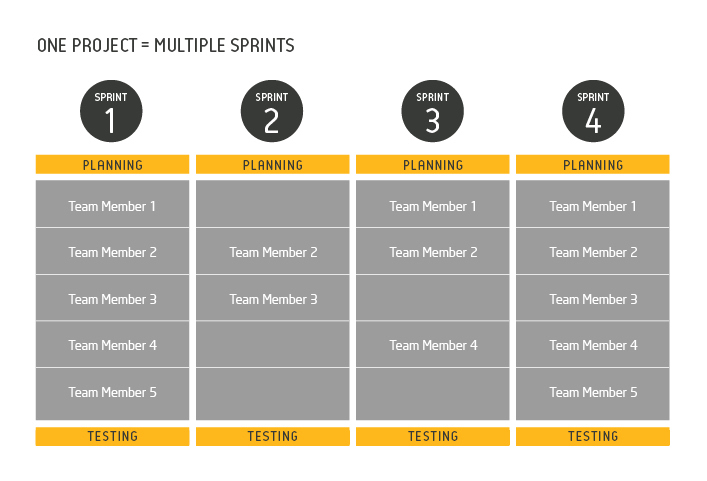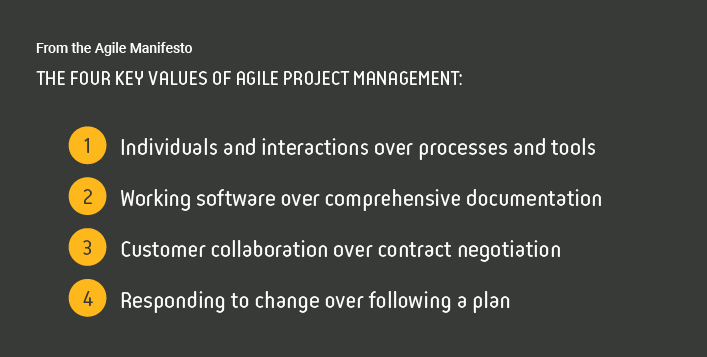Contact us today.
Our global experts are ready to help your business. Get in touch with one of our representatives today.
Send messageInstead, the aim is to get to the best possible results regardless of the path required to get there.Despite the flexible nature of agile project management, there are proven best practices and principles that must be adhered to in order to maximize success.
Agile project management is an iterative and incremental method of managing the design-and-build activities for engineering, IT and new product or service projects.In an agile environment, work is done in a highly flexible and fluid manner with iterative phases referred to as “sprints.” Sprints serve as micro-projects that begin with their own planning meetings, have their own goals, timeframes and deadlines, and end with testing and reviews before proceeding to the next sprint. Project team members may work on some or all of the sprints, allowing them to contribute when their expertise is required and focus on other tasks when it is not.
An agile project typically begins much like any other project —with a clear business or organizational need. With that need in mind, scope the project as accurately as possible to get a clear sense of the overall goal, as well as the time, money and resources needed to achieve it. Scope encompasses what the project is supposed to accomplish, along with a specific description of what the result will be. Defining scope is essential, regardless of what project management method you are employing. Without the clear goal and project parameters, the effort can quickly runoff the rails.
Agile project management differs from more traditional plan-driven or “waterfall” approaches in that the objective of the project is defined but the process, sequence and methods used to accomplish the goal remain flexible and open to change along the way. When it comes to traditional project management methods, change is often viewed as a threat to success —one that must be avoided at all costs. In an agile project environment, however, change and experimentation are encouraged in order to foster more efficiency and improve outcomes. Due to the flexible nature of agile project management, the project scope may be referred to as a project “vision,” and the initial pre-defined goals may evolve into a different set of desired outcomes.
An SOW defines the parameters of the project. They are particularly important for projects that require collaboration between contingent workers. The Agile Manifesto, often viewed as the foundation for the agile-related approach, defines one of the four key components of agile as “customer collaboration over contract negotiation.” Applied to a SOW, the definition means that while agreeing to the terms of a project is critical, just as important is allowing for free-flowing collaboration. Thus, you should establish a statement of work that captures the full scope of the project while also encouraging iterative development.
Statement of work templates are available from a range of online sources. Alternatively, your staffing partner should be able to provide you with templates that can be customized to your specific project. Agile statements of work focus on expectations and outcomes rather than day-to-day details, and they can help improve relationships between businesses and staffing partners.

The people on your agile project team will have the biggest influence on your project's success or failure. That's why, when assembling your team, you should look for individuals who understand the agile process and can help you steer clear of obstacles and roadblocks that can impede your progress. Be methodical when selecting team members, and consider these questions when making decisions:
Determine if your existing team has agile experience and expertise. If they do, assess whether or not they have the capabilities to execute the project from end-to-end. Simply having agile experience may not be enough to ensure that the project will run efficiently and achieve its desired goals. It's best to delve deeper into the experiences of your in-house staff to determine if they have worked through an entire agile life cycle. If so, get their insights on how the project progressed, their openness to work in an agile environment again and, of course, whether the project generated the desired results.
Further, determine what role they played —were they in a project management leadership role or more on the technical or development side? After assessing who on your team has experience with the agile method, ensure that you have access to the specific skill sets that your project demands. If you do not have people on your team with the requisite abilities, determine how you’ll obtain help from someone who does. If there’s a skill you’re likely to need to support additional projects in the future, perhaps you should consider making a new hire. If it’s a specialized skill that you’re not likely to need on a regular basis once your project is complete, consider working with a staffing partner to provide you with skilled contingent labor.
After taking stock of your in-house capabilities and assessing the skills and experience of potential team members, it's time to make strategic decisions. Simply having employees with agile skills and experience doesn't necessarily mean that executing the project exclusively with in-house talent is the best way to proceed. Instead, you should consider if those potential team members:
Finally, consider the benefits —fresh perspectives, new ideas and different skills —of utilizing outside resources to complement and enhance your in-house team.
Because of its iterative and always-evolving nature, successful agile project execution relies on frequent communication. Once the scope is set, the team is assembled and the timeline is developed, a series of efficient meetings should be established to keep the project on track and keep everyone informed.
Clarify the road map and plan for the first phase —or sprint —of the project. At this meeting, the project leaders can provide an overview of the project and communicate the most important components of the initial sprint. You can also use this meeting to define what will be accomplished during each successive sprint and address questions or concerns. The overall timeline of sprints will also be reviewed.
Given the flexible nature of agile projects, it is essential that team members are kept abreast of a project's progress every day. The objective of a stand up meeting is to provide a status update to all team members. These meetings are held in the same place and at the same time every day and should last no more than 15 minutes. Daily stand-ups are meant as a way to ensure everyone is in sync, not a forum for deep discussions. During the stand-up meeting, each team member is encouraged to answer three questions:
For multi-phased projects, it’s best practice to assess progress and revisit goals after a specific phase has been completed. Progress should be reviewed to determine success based on established goals and deadlines. This provides an opportunity for each team member to offer input or demonstrate functionality that might have been achieved during the period.
These more in-depth meetings provide the opportunity to share ideas on how to improve the process or even enhance the project's outcome. The team has the opportunity to identify what is working well and how to duplicate these successes in other aspects of the project. Conversely, this is also an opportunity to discuss what didn't work or meet expectations and how to avoid similar challenges moving forward. Take this opportunity to identify potential improvements or obstacles that might impact the project.
After each sprint, conduct testing and benchmarking to ensure that what is being created will actually work effectively in the final product and that the overall project is on track. Staffing partners can add value at this stage, as their experience developing benchmarks and testing procedures can be leveraged by project leadership. Staffing partners that have helped supply contingent labor for outsourced projects, or have completely managed these projects in the past, can easily apply the proper metrics and testing models to ensure success.
If you lack the in-house capabilities, experience and bandwidth to effectively execute an agile project management approach, you may want to tap the resources and expertise of an external staffing partner.Staffing companies with agile project experience can offer the capabilities, knowledge and talent your team needs to achieve its goals. Additional benefits include:
For the uninitiated, agile project management can elicit fears of uncertainty and trepidation. Yet, once you delve deeper into the process and gain a deeper understanding of how the agile method works, these fears can be replaced with confidence and better results. The key is to be disciplined and take the steps necessary to ensure the success of every agile project:
By following these guidelines, you can lay the foundation for a successful project that not only gets the job done, but very likely will generate innovations and advancements that far exceed original expectations.If you need help becoming agile, we can connect you with the experts and expertise you need to drive success for your team and your projects. To learn more, please contact us today.